
 SafeType Vertical Fixed Keyboard - Detailed Specification Sheet
SafeType Vertical Fixed Keyboard - Detailed Specification Sheet
 SafeType Vertical Fixed Keyboard - Detailed Specification Sheet
SafeType Vertical Fixed Keyboard - Detailed Specification Sheet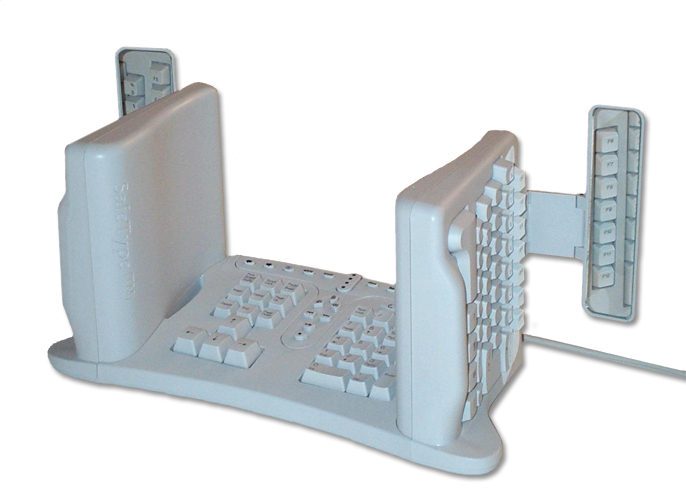
This is the only keyboard on the market which cannot be adjusted incorrectly, as it is fixed in the vertical position, which a Cornell University study has proven to eliminate high-stress postures which contribute to Repetitive Stress Injuries, such as Carpal Tunnel Syndrome.
Click here to see a 3 1/2 minute video presentation on the benefits of this keyboard.
This revolutionary keyboard is the only one that can place the user in a completely
orthopedically neutral position while doing data entry and cannot be adjusted
improperly by the user. In fact, it makes so much sense that once you see how
it works, you will probably understand more about keyboard ergonomics than most
keyboard designers! Take a look right now, and you will see why NASA and the
Technology Utilization Foundation chose this design as a promising future technology.
There is no recognized standard for a keyboard to be called ‘ergonomic’. Any keyboard manufacturer can call their keyboard ‘ergonomic’ without proving it beneficial in any way. But what makes a keyboard ‘orthopedically neutral’ so it doesn’t put you in potentially harmful positions?
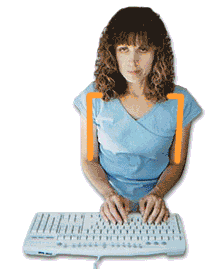 It
doesn’t just move the problem to another area of the body.
It
doesn’t just move the problem to another area of the body.
Most 'ergonomic' keyboards work very much like hitting your thumb with a hammer to make you forget about a headache. Sure, you forget about the headache, but didn’t you just trade your old problem for some new ones?
Whenever you try out a new ‘ergonomic’ keyboard, pay particular attention to where your elbows are. Do you have weightless, floating arms? Most of us don’t. That means if the design causes your elbows to be spread out in order to straighten the wrist, you are going to have to support those upper arms with straining muscles, because they can no longer relax and hang effortlessly from the shoulder.
Many split and angled designs simply move the problem from your wrists to your neck and shoulders. Do you need more tension in your neck and shoulders?
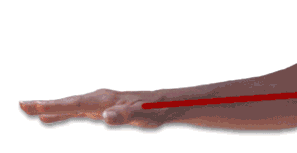 Researchers
have demonstrated that complete blockage of nerve signals can occur when pressure
equal to 40mm of Mercury (measured just like atmospheric pressure) is applied
for an 8-hour period. How much wrist extension does it take to create this much
pressure? Only 20 degrees! More detailed information, including references to
the specific studies, can be found on our “University Study” page.
Researchers
have demonstrated that complete blockage of nerve signals can occur when pressure
equal to 40mm of Mercury (measured just like atmospheric pressure) is applied
for an 8-hour period. How much wrist extension does it take to create this much
pressure? Only 20 degrees! More detailed information, including references to
the specific studies, can be found on our “University Study” page.
This warrants repeating: Complete blockage of nerve signals (!) can occur from this simple transgression for an 8-hour period!
On any keyboard, wrist rests should only be used for resting, not while typing. But as we all know, many people do lots of things they shouldn’t do, and this is one habit that is extremely hard to break. The best solution is to use a keyboard that inherently doesn’t allow significant wrist extension by its’ design. (such as the SafeType)
Deviation
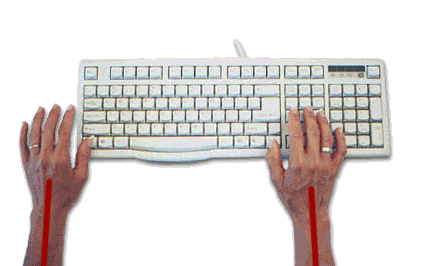 Most
of us learned to type on a standard, flat keyboard. The keys are all in nice,
neat rows. Unfortunately, that means we have to twist and turn our hands to
line them up with the keys in order to use the keyboard. Learning to use this
kind of keyboard is very much like learning to smoke. It was uncomfortable the
first time you tried it, but you gradually became used to it over time (and
it is still bad for you even once you get used to it).
Most
of us learned to type on a standard, flat keyboard. The keys are all in nice,
neat rows. Unfortunately, that means we have to twist and turn our hands to
line them up with the keys in order to use the keyboard. Learning to use this
kind of keyboard is very much like learning to smoke. It was uncomfortable the
first time you tried it, but you gradually became used to it over time (and
it is still bad for you even once you get used to it).
If you hold your wrists straight, then move your hand so that the little finger moves out and (pretend) back toward the elbows. This is called ‘ulnar deviation’ (you don't have to remember the terms to understand what's happening).
Holding your wrist in any position other than straight causes what physiologists call ‘static muscle loading’, or what you and I might call ‘constant tension’. Side effects of this include increased muscular energy expenditure, reduced muscular waste removal, and eventual discomfort or injury. The animation at right shows how wrists must be deviated to use a conventional keyboard.
Eliminating deviation of the wrist is the inspiration for lots of attempts to design ‘ergonomic’ keyboards. As we saw in our previous illustration (click here if you didn’t see it yet) this can result in simply transferring the problem to another area. There is only one ‘ergonomic’ design that is also ‘orthopedically neutral’ and eliminates the ulnar deviation by design.
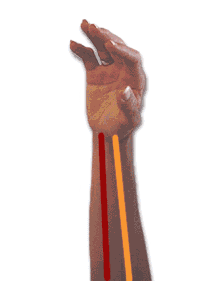
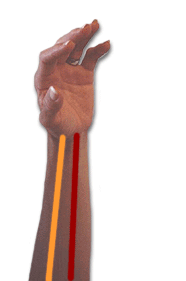 Pronation
PronationThe third major posture to avoid is called 'pronation'. Pronating the hand simply means turning it so the palm faces downward. The bones in the forearm are actually straight and essentially parallel when the hands are slightly 'supine', with palms facing upward.
Observe how 'pronating' the hands (turning the palm downward) causes the bones in the forearm to cross and 'scissor' the soft tissues in the arm. It forces blood vessels and nerves between two hard objects (your bones) and then puts a crushing pressure on them! Do you see how this could be harmful over long periods of time?
Now, as you sit down at a conventional flat keyboard, what movements do you have to perform to put your fingers on the right keys?
Pronation, Deviation and Extension... all at the same time!
The only ‘ergonomic’ keyboards that will help prevent injury are those that cannot be adjusted improperly, and which eliminate significant amounts of extension, deviation, and pronation of the wrist. Anything else is a waste of your money.
Simply use a hand-shake position with palms facing each other, and with your index fingers on the familiar ‘home’ keys you begin to type, without thinking about each letter -- just like you do now with other keyboards. It is familiar in layout so there is no re-training required for a touch typist. However, the adjustable mirrors are there so you can see keys on the less-familiar top rows if necessary, and the lettering on the keys is reversed so you can read it properly in the mirrors.
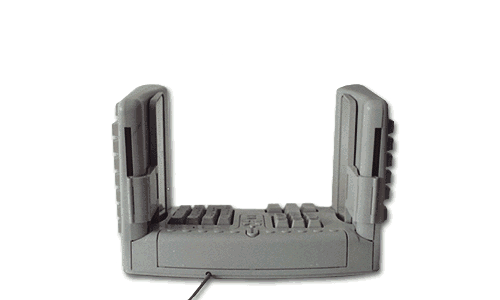 How
Mirrors Work
How
Mirrors Work
Raise and lower the mirrors by pushing only on the hinge on the back of the keyboard. Get as close to the slot as possible. Push up from the bottom to raise the mirrors. To lower them, push down from the top. The animation below shows the keyboard from the back.
The mirrors slide up from their stowed position, and it is important that you push up in the correct place to avoid damage.
The mirrors are hinged on the back side of the keyboard, so that once they slide up they can be moved around to the outside of the keyboard and positioned to reflect the keys to the user.
Many users do not use the mirrors at all. They are included primarily to help
with the ‘Function’ and ‘Numeric’ rows of keys because many
typists are less familiar with those keys than the letter keys that they use
constantly. As with any keyboard, most users will be more efficient as a touch
typist if they do not use visual references. Do not use the mirrors until you
understand how they work and where to lift them. Pulling on the mirrors in the
wrong place could cause them to break.
Interface: USB
Keyswitch Life: 10 million keystrokes
Numeric Keypad: In center portion of keyboard or check out our supplementary
numeric keypads in the keypads section under OTHER in the online catalog.
Warranty: One Year. Repair or replacement will be manufacturer's option.
The Micwil Group of Companies
Ergonomics Portal: ErgoCanada.com
P.O. Box 9022 Saskatoon, SK, Canada S7K 7E7
Phone: (306) 382-5995 Fax: (306) 382-4995
Toll-Free: (866) 335-3746 (ERGO)
Email: sales@ergocanada.com
Check out our other portals:
ExtremeGamingDevices.com
- Specialty gaming products for extreme gamers
ErgoLaptop.com - Ergonomic products
for laptop users.
BirdXCanada.com - Bird control products
All materials copyright © 2007 The Micwil Group of Companies.